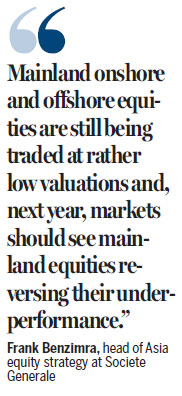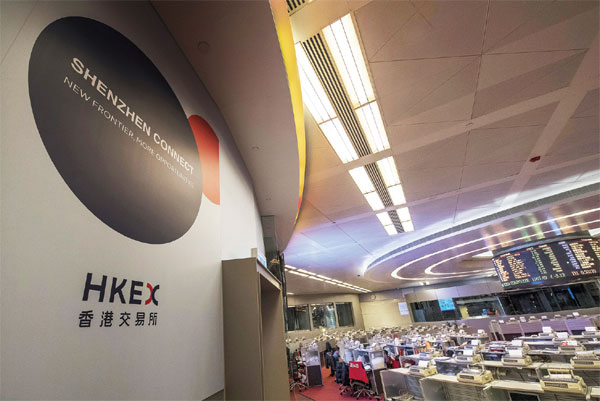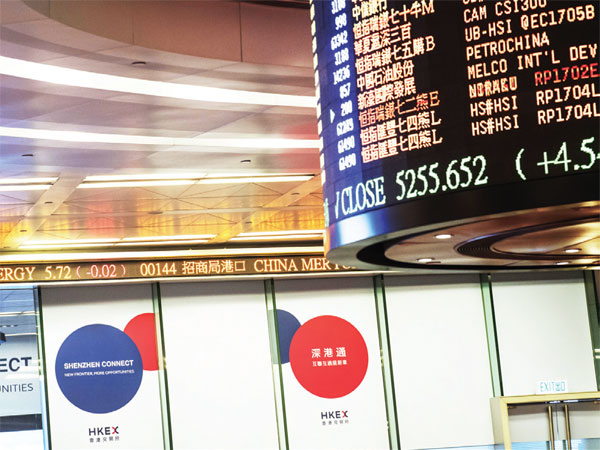Mainland, HK markets set to lead the pack in 2017
Updated: 2016-12-14 07:32
By Duan Ting in Hong Kong(HK Edition)
|
|||||||
|
Despite a downward swing in the past few days, the Chinese mainland and Hong Kong equity markets are seen to lead a regional rally next year, lifted by a recovery in corporate earnings, attractive valuations and buoyant liquidity that will swell northbound and southbound fund inflows under the Shenzhen-Hong Kong stocks trading program, experts say. David Paul Morris / Bloomberg |
Experts upbeat on shares riding high on earnings rebound, heavy liquidity
Equity markets on both the Chinese mainland and in Hong Kong are poised to put up an impressive show next year, unleashing a fresh regional rally and outperforming other emerging markets, analysts say.
Central to the big push will be the peripheral effects of the newly launched Shenzhen-Hong Kong Stock Connect - the second stocks-trading link between the SAR and the mainland - which will accelerate northbound and southbound fund inflows, with investors being particularly drawn to the mass of innovation-themed enterprises listed on the Shenzhen bourse.
The Hong Kong and mainland stock markets have seen a downward swing in the past few days, erasing last week's gains propelled by the kick-off of the second stocks "through train" on Dec 5. Mainland shares have shed about 3 percent since Friday to a one-month low as regulators moved to slash insurers' risky share-purchasing and profit-taking activities that leveraged on high-risk products.
The Hong Kong market's weakness has also been exacerbated, to a certain extent, by apprehension over the course of future relations between the mainland and the United States after US President-elect Donald Trump takes office next month.
John Woods, chief investment officer, Asia Pacific, at Credit Suisse, said that, despite the markets' setback lately, the mainland and Hong Kong bourses are set to lead a regional rally next year, lifted by a recovery in corporate earnings, attractive valuations and buoyant liquidity that will swell northbound and southbound fund inflows under the Shenzhen-Hong Kong stocks program.
Frank Benzimra, head of Asia equity strategy at Societe Generale, believes that mainland onshore and offshore equities are still being traded at rather low valuations and, next year, markets should see mainland equities reversing their underperformance.
Specifically, for the Hong Kong stock market, Cliff Zhao Wenli, chief strategist and deputy head of equity research department at China Merchants Securities (HK) Co Ltd, noted that the city's benchmark Hang Seng Index (HSI) has been scaling back from its peak reached in October, and is likely to touch the bottom of 20,000 points around February next year by which time there would be another splash by southbound investors.
He expects the HSI to fluctuate between 20,000 and 25,000 points, and the Hang Seng China Enterprises Index between 8,500 and 11,500 points in 2017.
Kevin Anderson, head of investments, Asia Pacific, at State Street Global Advisors, said the launch of the Shenzhen-Hong Kong connect has whetted international investors' appetite for the mainland market, as the Shenzhen bourse hosts a number of consumer and domestic economy-focused companies.
The new stocks trading link will further strengthen the case for MSCI (Morgan Stanley Capital Index) to include A shares for a number of reasons, according to most analysts surveyed, although there's still some more work to be done, such as improving regulation policies and investment logic.
In anticipation of the US Federal Reserve (Fed) raising interest rates once this week and twice for a total of 0.5 percent by the end of next year, analysts reckoned that the macro backdrop for Chinese mainland stocks in 2017 is likely to be dictated by two upcoming key political developments - Trump's inauguration as the new US president on Jan 20 and the mainland's leadership transition, which is expected to be completed after the 19th National Congress of the Communist Party of China in November next year.

Peter So, co-head of research at CCB International Securities Ltd (CCBIS), said he expects to see most stocks surge in the first half of next year, with a gradual 8.9 percent, year-on-year recovery in the HSI by late 2017. For the second half of next year, higher interest rates in the US and Hong Kong, coupled with a strong greenback, may cap the market upside.
For Hong Kong and the mainland, CCBIS favors stocks in the energy and commodities, infrastructure, healthcare, consumption upgrade and TMT (technology, media and telecom) sectors.
Global investment bank Goldman Sachs has set its sights on A shares instead of H shares, with its key themes being beneficiaries of reflation, resilience in new economy in China, SOE (State-owned enterprise) reform beneficiaries, and renminbi depreciation winners.
Regulators had earlier pointed out that with the start of the latest stocks connect, there would be an IPO (initial public offering) link to be included in the mutual market.
According to financial services firm Ernst & Young (E&Y), there would be 117 IPOs in Hong Kong for the whole of this year, raising a total of HK$196.1 billion and surpassing other global IPO hubs in terms of funds raised although the number of IPOs and the value of funds raised would be down 3 percent and 25 percent year-on-year, respectively.
The number of IPOs and the amount of funds raised in the Growth Enterprise Market would hit a record high this year since its introduction in 2003.
Ringo Choi, managing partner for China South and Asia-Pacific IPO leader at E&Y, reckoned that the Shenzhen-Hong Kong stocks-trading program and the potential IPO connect will lure more investors to buy H shares, thus boosting liquidity, but the impact on the Hong Kong IPO market would be limited, explaining that the vitality of the IPO market relies mostly on valuation and liquidity in the secondary capital market.
Financial sectors, including banks and securities and leasing companies, accounted for 90 percent of the funds raised by the top 10 IPOs in 2016, and are estimated by E&Y to continue as the leading sector next year.
As worries grew over the likelihood of the US Fed kicking off the fresh round of its interest-rate hikes this week, the HSI eked out a gain of just slightly more than 13 points, or 0.06 percent, on Tuesday to close at 22,446.7, while the Hang Seng China Enterprises Index put on 0.21 percent to 9,719.94.
The Shanghai and Shenzhen stock markets saw a slight rebound at the close of trading, picking up 0.07 percent and 0.29 percent, respectively.
tingduan@chinadailyhk.com
|
The Hong Kong bourse is likely to surpass other global IPO (initial public offering) hubs in terms of funds raised this year, according to financial services group Ernst & Young. David Paul Morris / Bloomberg |
(HK Edition 12/14/2016 page9)

